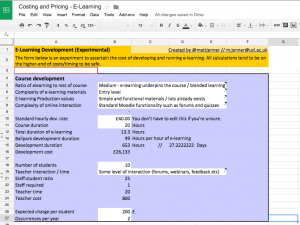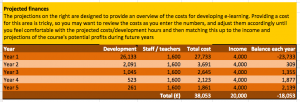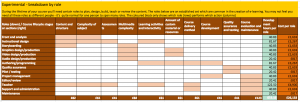What is the cost of developing e-learning? Try our calculator
By Matt Jenner, on 22 July 2015
Q: What is the cost of developing e-learning?
A: It depends
Argh – this answer is not good enough.
E-Learning is a big industry, so why does the cost of making ‘some’ feel so mysterious? Increasingly the question of ‘how much will this cost?’ is cropping up. This is a perfectly valid question and one that really demands a better answer than the one above. For too long the response of ‘it depends’ comes up, or something about a piece of string. This isn’t cutting it so after some research (there isn’t much out there) we created an E-Learning Costing Calculator so you can start putting in some numbers and start to see some cold, hard, financials. Hurray?
Go – play with what we’ve created
Access E-Learning Costing Calculator on Google Sheets
Warning: multiple users will obviously see one another’s calculations but I couldn’t find a better way of doing this while also retaining Alpha status for testing. Ideas welcome in the comments below…
Images / captures (of the above sheet)
Main tool, questions and numbers input:
Cost and recovery
Charts for the boss
Breakdown by role
Approximations!
If you spend any time in the sheet you’ll notice there are some approximations going on in there (quite a few). It doesn’t produce an exact answer (because it really does depend). I think we’ve been asking the wrong question. We still need to ask – what data do we have to suggest how much e-learning might cost? How can we generalise and remain detailed enough to find ballparks? How close can we get to accuracy? and finally, What are we missing to increase accuracy?
Disclaimer: so far all the work on this comes from smaller, shorter courses (CPD, continuing education). Moocs and fully accredited courses are slightly different. The biggest problem is to add in some economy of scale (more on this in Maths).
Seeking improvement
Firstly – I want people to roadtest this spreadsheet. So please contact me and we can collaborate in Google Sheets (for now). I’m confident we could get a little closer to understanding why and it involves maths, early solutions and more questions.
Maths
Bryan Chapman, Chief Learning Strategist for Chapman Alliance asked in 2010 how long does it take to create e-learning:
[slideshare id=5198860&doc=howlong-100914094357-phpapp02]
Bryan surveyed 4000 learning development professionals and obtained data (US-based) on CPD and short courses. He created a series of development hour timeframes based on teaching approaches of f2f and three-level e-learning (basic, intermediate and advanced). For each approach he discovered the number of development hours required to create one hour of ‘e-learning’ (vague as it depends on your teaching approach). These numbers were the primary driver to start calculating an idea of costing, and the questions to ask.
This is the only data found. There’s corporations offering consultancy, and sure they have their ROI models (of course, it’s business). There’s bloggers and co. with their ideas and comments – but nothing with much evidence, especially when compared to Bryan’s work.
Economy of scale / new vs old
One problem with all this is that all costs tend to follow the rules of economies of scale. Producing one of anything tends to be proportionally more expensive than 10, then 100, and so on. Logically one hour of e-learning would cost a fair whack – say £15k. But the second should be cheaper, say £10k. Then from here you should see some sliding scales of efficiency. This isn’t so easy to build, so I omitted it in the sheet (for now). Idea welcome on this part.
New content is probably not the same cost as reusing old. Converting old content vs producing new content both come with different costs. To try and not complicate things it’s best to avoid this question for now, but see a sliding scale could help here – but I don’t know how to calculate the cost of conversion and comparing it to the cost of creation – so it’s lumped in together (for now).
Solutions
Running a few generalisations – the data from the Chapman Alliance can be used to start calculating the cost of courses. By taking some known courses, and their approximate costs, we simulated with some UCL courses how much they cost. During a project (UCLeXtend) we had provided some seeding resource to prime the new platform and provide examples to the wider community of what’s possible. Due to the transparency of these courses we could also see how much they all cost, and whether any calculations made were accurate. Sometimes the numbers hurt (never making a profit in this corner…) they also looked kinda accurate.
This motivated the creation of an E-Learning Costing Calculator – which we’re now crowdsourcing people’s opinions on to improve.
Questions
Armed with one data source (dangerous, I know) I looked to break it back down and discover if it could be reverse-engineered to build a calculator for everyday use. The idea was to ask broad questions within the calculation to then align with the data from the Chapman Alliance’s research. I think there are more questions to ask, but how to also generalise for calculating answers?
See also
UCL recently become friends with the IOE. A tool they have is the Course Resource Appraisal Modeller -it’s much more detailed than this and I think it goes a long way to answering some of the questions I have posed. It also takes a fair amount of time and information to complete it. I can see the validity of both, or (better) one feeding into the other / merging. What do you think? Have you used CRAM?
http://web.lkldev.ioe.ac.uk/bernard/cram/launch.html
What’s next?
Please comment on this, in the sheet or in this post (or Twitter). I feel a bit stuck on this now, so feedback is essential to move forward.
 Close
Close






